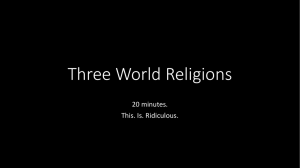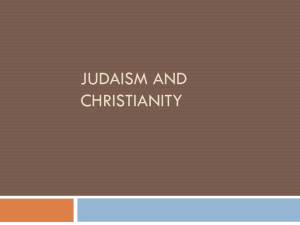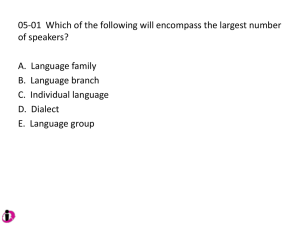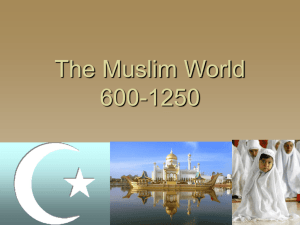Development and Spread of Monotheism
advertisement
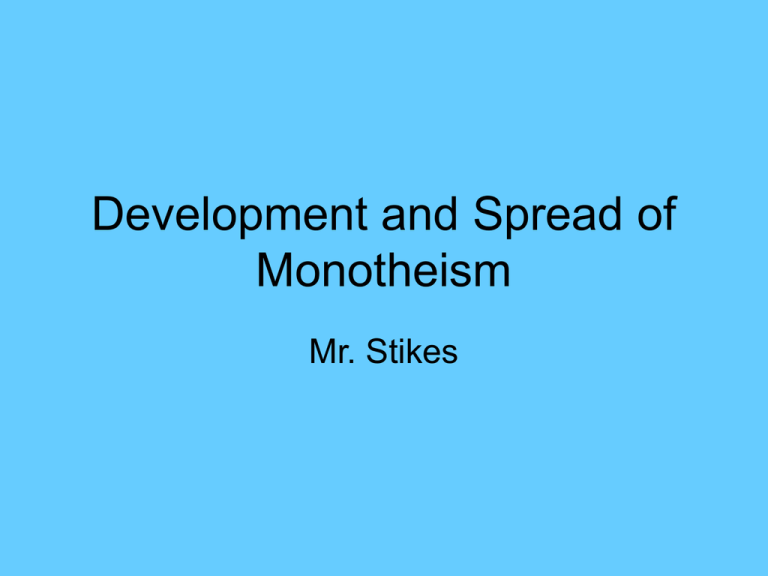
Development and Spread of Monotheism Mr. Stikes What is monotheism? • Monotheism: belief in one god • Major monotheistic religions today: – Judaism – Christianity – Islam Brief History of Monotheism • First major monotheistic religion: – Zoroastrianism • Remember? Zoroastrianism • Zoroaster – Priest, worshipped a god named Ahura Mazda • Ahura Mazda is worshipped as the only god • Ahriman is opposite of Ahura Mazda – Followers have a moral choice • To do right or wrong – Right = Supportive of Ahura Mazda – Wrong = Against the wishes of Ahura Mazda – Good deeds are rewarded, bad deeds are punished • People have only themselves to blame for their position in life – Holy book is called the Avesta What happened to Zoroastrianism? • Still practiced in some form in parts of Iran • Has since been replaced by other monotheistic religions based on Judaism • Why? – Lack of expansion? Three Great Monotheistic Religions • Also called Abrahamic Religions • Islam, Christianity and Judaism • All trace their heritage from Abraham. • Figures in common – Abraham (through son Ishmael for Islam, Isaac for Christianity and Judaism), Noah, Adam, Moses Common Characteristics • We will identify 9 common characteristics that are shared by the Abrahamic religions 1. Monotheism • All three religions are monotheistic • Jews and Muslims sometimes claim the doctrine of the Holy Trinity (adopted by the majority of Christians) constitutes polytheism. Common Characteristics 2. A prophetic tradition (tradition of prophets) • All three religions recognize figures called "prophets“ • • Prophet: A person who speaks by divine inspiration or as the interpreter through whom the will of a god is expressed. The lists of prophets differ, as do the interpretations of the prophetic role. 3. Semitic origins • Began in the Middle East • • Semitic = “Middle East” + Origin = “Beginning” Judaism and Christianity originate in the Jewish populations, while Islam originated among Arabs respectively. Common Characteristics 4. A basis in divine revelation rather than, for example, philosophical speculation or custom. • Divine Revelation: God reveals himself to a man, who then teaches others • Divine = “Godly” + Revelation = “to show or reveal” 5. An ethical orientation (importance of ethics) • • Ethics: A theory or a system of moral values All three religions speak of a choice between good and evil, which is associated with obedience or disobedience to a single God. Common Characteristics 6. A linear concept of history • Begins with the creation and the concept that God works through history. vs. 7. Association with the desert • some scholars believe has influenced the development of these religions Common Characteristics 8. Acceptance of some of Judaism's religious obligations found in the Bible as a spiritual devotion to the traditions of Abraham and not Moses by Christianity and Islam, including those which have parallel accounts in the Qur'an, such as the stories of Adam, Noah, Abraham, and Moses. Common Characteristics 9. Redemption • A belief that includes God redeeming the World and a resurrecting the righteous. Judaism Name of Religion: Judaism Monotheistic or Polytheistic? Monotheistic Who is worshipped (Name of god/God)? Yahweh (Hebrew word for God) Is not generally written down or said aloud Judaism • Holy Book/Scriptures: Torah (first five books of the Bible) • How was the religion founded? History began with the creation of man, the first five books of the Bible detail the struggle of the Jews and of the Patriarchs – Abraham, Isaac, and Jacob and Moses, who led the Jewish people out of slavery in Egypt Judaism “Father” of the religion: Abraham Major City (why is it important): Jerusalem – Where the temple was, site of Western (Wailing) Wall Judaism Major divisions of the religion: Orthodox – believe that the Torah is the word of God and unchanging Conservative – Jewish law is always changing with the times, Torah inspired by God, not dictated by God Reform – Rejection of ceremonial Jewish law, Jews should pick what they believe – Judaism as a religion not as a race or culture Judaism Who is a member? Anyone born to a Jewish mother and any convert – once a Jew, always a Jew How do they pray? 3 times daily, a fourth on the Sabbath and holidays Where do they worship? Synagogue Judaism What holy days do they recognize? Weekly – Shabbat - weekly day of rest lasting from shortly before sundown on Friday night to shortly after sundown Saturday night, commemorates God's day of rest after six days of creation. No work allowed on Shabbat. Judaism What holy days do they recognize? 3 Pilgrimage Fesitvals – Passover, Pentecost, and Tabernacles High Holy Days – Rosh Hashanah and Yom Kippur Other – Hanukkah and Purim Judaism What makes this religion unique? In many places in the world, to be “Jewish” is to be not just someone who follows the Jewish religion, but also a separate Jewish race and culture. Jewish people have customs that are unique and make them stand out, such as wearing of a Yarmulke, following certain dietary regulations and Bar and Bat Mitzvahs. Christianity Name of Religion: Christianity Monotheistic or Polytheistic? Monotheistic Who is worshipped (Name of god/God)? God Christianity Holy Book/Scriptures: Bible How was the religion founded? Jesus of Nazareth preached that he was the Jewish Messiah (around 30 A.D.). His followers, called disciples, spread his teachings throughout the Roman world. Christianity “Father” of the religion: Abraham Major City (why is it important): Jerusalem Site of Jewish temple Place of Jesus’ crucifixion Christianity Major divisions of the religion: Roman Catholic – Recognize the supremacy of the Pope; original branch Orthodox – split from Catholics over icons Protestant – split from Catholics over corruption and reform measures Christianity Who is a member? Varies; generally defined as anyone who claims to be a member How do they pray? Varies Where do they worship? Church, Basilica, Temple, Cathedral Christianity What holy days do they recognize? Weekly – “Sabbath” – From the Jewish tradition. Varies in date, but for most is on Sunday. Major Seasons – Lent, Advent Major Holidays – Christmas, Easter Christianity What makes this religion unique? Variety – understand that Christianity is very fractured. There are many different versions throughout the world. In the United States especially, Christianity is very difficult to define. Islam Name of Religion: Islam Monotheistic or Polytheistic? Monotheistic Who is worshipped (Name of god/God)? Allah (Arabic word for God) Islam Holy Book/Scriptures: Qur’an (Koran) How was the religion founded? Gabriel, an angel, appeared to Muhammad in Mecca around 610 A.D. and provided revelations that became the Qur’an Islam “Father” of the religion: Abraham Major Cities (why each is important): Mecca Site of Muhammad’s revelation, Kaaba Medina Muhammad’s flight (hijra) from Mecca Jerusalem Site where Muhammad went to heaven Islam Islam Major divisions of the religion: Sunni – believe that central authority could be passed from Muhammad to any learned Muslim Shia – believe that central authority should be passed to those related to Muhammad (or, later, chosen by Allah) Islam Who is a member? A person who believes in and consciously follows Islam; called “Muslim” Generally, this involves following the Five Pillars of Islam: 1. Testimony of faith 2. Prayer 3. Almsgiving/Charity 4. Fasting 5. Pilgrimage (Kalima) (Salat) (Zakat) (Sawm) (Hajj) Islam How do they pray? 5 times a day (pre-dawn, noon, afternoon, sunset, evening) Where do they worship? Mosque Islam What holy days do they recognize? Weekly – Friday (Jumu’ah) – prayer meeting at noon Major Seasons – Ramadan, Hajj Major Holidays – Eid al-Fitr (Festival of Fast Breaking), Eid al-Adha (Festival of Sacrifice) Islam What makes this religion unique? The importance of universality of community and family Spread of Judaism • The Hebrew nation – “Israel” – is decentralized at first – Forms first after the Exodus from Egypt – Relies on interaction between 12 tribes • Leaders are chosen when needed, amongst those who seem to be ordained by Yahweh – Gradually a permanent monarchy is developed Spread of Judaism • Israel eventually splits into two kingdoms – Israel, the 10 northern tribes – Judah, the 2 southern tribes • These are turned into vassal states by the Assyrians (600’s B.C.E.) and conquered by the Babylonians (597 B.C.E.) * – The Babylonians deport the Judaic king and many of societies elite (they are sent to Babylon) – The Babylonians destroy Solomon's Temple (1st) “Babylonian Captivity” or “The Exile” Spread of Judaism • After the Persian conquest of Babylon, the Jewish exiles are allowed to return and construct the 2nd Temple in 516 B.C.E. • After Alexander the Great’s conquest (332 B.C.E.), the Jewish people become increasingly Hellenized * – Hellenized: made like the Greeks Spread of Judaism • Hellenized Jews begin to move throughout the Eastern Mediterranean – They take Judaism with them • Israel eventually falls under the control of the Romans * – Jewish revolt – A.D. 70 – Romans destroy the 2nd Temple “Diaspora” • Diaspora: * – Dispersion of Jewish people from Israel throughout the remainder of the world • 2 main time periods: – Babylonian Exile – Roman • Result: Spread Judaic ideas to major cities throughout Europe and the Middle East * – Jewish beliefs are known to many Diaspora – Hellenistic World • Shows dispersion of Jewish culture through the Hellenistic World Later Diasporas • Map to the right – Shows expulsion of Jews from areas of Europe • Map to the left – Movement of Jewish populations throughout Europe Jewish Enclaves • Jews from the Diaspora eventually settled in eastern Europe and Asia * • The Kingdom of the Khazars, in what is today Russia, converted to Judaism around A.D. 800 – This empire lasted until almost A.D. 1000, when it was conquered by the people of Kievan Rus Khazars Land of the Khazars Spread of Christianity • Early – Spreads from Israel, thanks to efforts of early followers * • • • • Paul – throughout Hellenistic world Thomas – east to Mesopotamia, Iran and India Mark – south to Africa Peter – to Rome Spread of Christianity • Persecution followed the spread * – Martyrs – people who chose to die rather than give up their beliefs – Why? • Monotheism went against accepted norm = polytheism • Urban religion = concentrated in cities * – Why? • Travel, high concentration, etc. Spread of Christianity • Conversion of Rome – Constantine * • Battle of Milvian Bridge (28 October 312) – Constantine v. Maxentius, over being Emperor (Augustus) of Western Empire – “By this sign, you will conquer” » Soldiers paint cross on shield? • Protector of Christianity * * – Edict of Milan, A.D. 313 » Religious toleration in Empire – Death-bed convert to Christianity • Convenes Council of Nicea (A.D. 325) – Uniformity in Church (Nicene Creed) » Arianism Spread of Christianity • Arianism: * – Denied divinity of Jesus • Jesus as less than God – Declared heretical by Council of Nicea • Heresy: an unorthodox belief which is not recognized by the mainstream faction of a religion – Constantine’s Role in Arianism • Christianity as State Religion – Christians had to get along! Spread of Christianity • Conversion of Rome – Theodosius * • Makes Christianity the official religion of Roman Empire – 27 February 380 Spread of Christianity • Early Church “Fathers” – Augustine of Hippo (A.D. 354-430) * • North African • Famous Works: – City of God: Contrasts good living with bad living – Confessions: Augustine’s conversion Spread of Christianity • Early Church “Fathers” – Ambrose of Milan (A.D. 337-397) • Helps convert Augustine – Jerome (A.D. 347-420) • Translates Bible into Latin (Vulgate) Spread of Christianity • Organization of Church Patriarchs (Rome, Constantinople, Alexandria, Antioch, Jerusalem) Patriarch at Rome eventually assumes title of Pope and claims to be head of all other churches Bishop Bishop (Leads a diocese) (Leads a diocese) Priest Priest Priest Priest (Leads a parish) (Leads a parish) (Leads a parish) (Leads a parish) Spread of Islam • Muhammad dies in A.D. 632 – Who is his successor? – Caliph: supreme leader of Islam, chosen as successor to Muhammad • Expansion under Muhammad – Conquers much of Arabian peninsula for Islam Spread of Islam • First Four Caliphs DID YOU KNOW: All four of the Rightly Guided Caliphs were related to Muhammad? Muhammad married the daughters of Abu Bakr & Umar and both Uthman & Ali were married to a daughter of Muhammad “the Rightly Guided Caliphs” – Chosen for life, close friends/relatives of Muhammad 1. Abu Bakr (A.D. 632-634) • • Collects writings which will become the Qur’an Gained territory in Syria and southern Iraq 2. Umar ibn Khattab • Harsh ruler, gained territory in Iraq and Iran 3. Uthman ibn Affan • (A.D. 644-656) Authorized official version of Qur’an, had all others destroyed 4. Ali ibn Abi Talib • (A.D. 634-644) (A.D. 656-661) Opponent of Uthman, reign marked by revolt amongst supporters of Uthman Spread of Islam • Umayyad Dynasty (r. 661-750) – Members of family favored by Uthman – Begins with Muawiya, who rebelled against Ali • Muawiya was Governor of Syria • Moves capital to Damascus, present day Syria – Spreads from Spain to India • Why? – Jihad (Holy war to spread Islam – Weakened Byzantines, Persians & North Africans Umayyad Caliphate at Greatest Extent Spread of Islam • Division of Islam under the Umayyads – Sunni/Shia split • Shia, in Iraq, only recognized leaders from the family of Ali (leads to persecution under the Umayyads) Central Question leading to the split: Was the Caliph a spiritual leader or a political leader? • Sunni, the majority, recognized any capable leader Spread of Islam • Division of Islam under the Umayyads – Other divisions • Leads to rise of Sufi Islam, or Sufism – Inward, mystical practice of Islam – Development caused by “worldliness” of the Umayyads – Use prayer, meditation, fasting and spiritual writing to connect directly with God Spread of Islam • Fall of the Umayyads – Discontent, especially among the Shia and non-Arab Muslim populations • Why? Emphasis on single Muslim culture – Revolt, from A.D. 747-750 • Overthrows Umayyad dynasty, makes Abu’l-’ Abbas the new Caliph, first of the Abbasid dynasty Spread of Islam • Abbasid Dynasty (A.D. 750-1258) – Move capital to new city of Baghdad – Emphasized diversity instead of insisting on everyone accepting Semitic Arab culture – Gradual decline of Muslim state Spread of Islam • Culture – Language: Arabic • The Umayyads forced all conquered peoples to use Arabic • The Qur’an is read in Arabic – Family: • Limited polygamy allowed – Men could have up to four wives if all were treated equally Spread of Islam • Culture – Status of women • Allowed to own property & divorce her husband • Influential in government and arts – Education • Boys entered school at age 7 • Free for the poor, those who could afford it had to pay • Madrassa – theological school, for higher education Spread of Islam • Trade – Empire sits between Europe, Africa and Asia – Main goods/routes: EUROPE Buyers bring goods to Europe through Italy UMAYYADS / ABBASIDS Locally made: Spices, Textiles, Glass, Carpets AFRICA Gold, Ivory, Slaves CHINA Silk INDIA Rubies SOUTHEAST ASIA Spices Spread of Islam • Agriculture – Variety of crops • • • • • • • • • • • • • • • • • Wheat Rice Beans Cucumbers Celery Mint Almonds Blackberries Melons Apricots Figs Olives Cherries Apples Pears Bananas Flowers • Farming Methods – Crop Rotation CROP C CROP A CROP B – Irrigation Spread of Islam • Advancements – Literature • Translation of many texts • Qur’an • One Thousand and One Nights (Arabian Nights): Sinbad the Sailer, Ali Baba and the Forty Theives • Kalila and Dimma: animal fables that present moral lessons • Libraries: Vast numbers; at Cordoba, Spain (over 500,000 books) – Astronomy and Geography • Improved astrolabe • First accurate maps of Eastern hemisphere • Ibn Battuta (A.D. 1304-1369): famous writer, wrote about his travels Spread of Islam • Advancements – Mathematics • Adopted Gupta place value system and zero • Invented algebra, developed trigonometry • Expressed equations to define curves and lines – Chemistry and Medicine • Develop alchemy (lead into gold?) • Founded optics (study of light & sight) • al-Razi (A.D. 865-925): classified objects as animal, mineral or vegetable • Ibn Sina (A.D. 900’s): Canon of Medicine, summarized medical knowledge at the time
